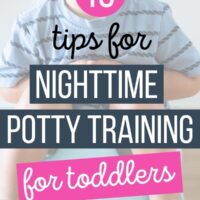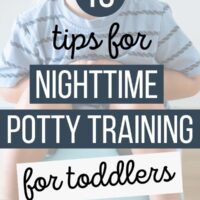This post may contain affiliate links, meaning I may earn a commission for recommending products. Read my disclosure policy for more info.
If you’re a parent of a toddler, chances are you’ve either started potty training or it’s on your to-do list.
Potty training can be a tough phase for parents, especially if this is your first child.
Nighttime potty training can be especially tricky.
Let’s be honest. Bedwetting is stressful when you want nothing more than to get a full night’s sleep (without having to get up in the middle of the night to clean up pee)!
Thankfully, there are a few ways to make it easier on yourself so that everyone gets through this process with their sanity intact.
Here are our top 10 tips for potty training at night!
Daytime vs nighttime potty training
Before we jump into the tips, it’s important to know that nighttime potty training can be harder for toddlers than daytime training.
Daytime potty training usually starts with a child being aware of when they have to go and then communicating that need to their parent.
Nighttime potty training requires that a child be able to do this at night while they sleep.
They will also have to get out of bed and use the potty in the middle of the night, even if they don’t want to.
It’s very normal for a toddler to take a little longer to get the hang of nighttime potty training– Even if they have mastered potty training in the daytime.
How long does nighttime potty training take?
You’re going to hear this a lot, but every child is different.
Some toddlers will be easy to potty train at night. Others may need some extra time. Both scenarios are completely normal.
Once you start nighttime potty training, it may take a little while for the bedwetting to completely stop. The key is not to stress it and continue to be consistent and encouraging.
Also, it’s important not to shame your child when accidents happen. This is a learning process, and it can be as difficult for them as it is for you.
Stay positive even when it’s hard!
When should you start potty training at night?
Some potty training experts say that you can pair nighttime training with daytime training.
In my experience as a mom of 2 boys– It’s easier if you wait until your child has gotten the hang of daytime potty training before you get serious about nighttime training.
That being said, if you want to give it a try, there’s no reason why you can’t try both at the same time and see how it goes.
But at what age can I start nighttime potty training?
For the longest time, parents have been told that once their child turns 2 years old they should be able to stay dry at night.
However, this isn’t true for every single child. Some may need more time!
Here’s a good rule of thumb:
If your toddler has responded well to daytime potty training and they are 2-4 years old, they’re probably ready for you to get serious about potty training at night.
Why is my potty-trained child still wetting the bed at night?
The most common reason toddlers wet the bed at night (even if they have mastered using the potty during the day) is because they aren’t awake when their bladder tells them that they need to go.
Some toddlers are heavy sleepers!
Or, they get out of bed and can’t hold it long enough to get to the bathroom.
Getting up in the middle of the night to use the bathroom is hard for some kids.
If your toddler still has multiple accidents during the day or if they are younger than 3, it might be best to give them a little more time before continuing the potty training at night.
Nighttime potty training tips
1. Prepare your toddler’s bed
Preparing your toddler’s bed for accidents is so important because they WILL happen when you first begin potty training at night.
This is a very normal part of the process!
So, we have two main goals here:
- Protect your mattress
- Make it as easy as possible for you to clean up when you’re half asleep
First, if you haven’t bought one already, a waterproof mattress protector is a must-have. The last thing you want is for your toddler’s mattress to smell like pee.
Next, you will need an absorbent bed pad/mat. You can choose disposable bed pads or washable ones.
I’m a fan of washable ones so that you don’t have to keep buying them, but you can take your pick.
Now, whether you want to place the pad underneath the sheet or over the sheet will depend on how wiggly your toddler is when they sleep.
We had better luck placing the mat underneath the sheet.
Once you’ve done this, don’t forget to set aside an extra bed sheet (and any other bedding your child uses) and you’re all set.
2. Dress your toddler in simple pajamas
Next, skip the complicated pajamas.
Those button-up pajamas with built-in feet may look super adorable, but they’re a little harder to change when it’s 2:00 in the morning and you’re groggy and blurry-eyed.
Instead, try to find PJs that are easy to get off and on (preferably without buttons) so that nighttime potty training is easier on you both.
3. Ditch the Pull-Ups
Before I begin my anti-Pull-Up speech, I want to start by saying that Pull-Ups can sometimes be helpful.
When you’re in the early stages of potty training, they are nice to have when you’re traveling to help prevent accidents in the car seat. Nobody wants to be cleaning a car seat when you’re halfway to grandma’s house.
And, when you’re still daytime potty training and your toddler isn’t quite ready for nighttime training. I believe Pull-Ups can be helpful with this scenario as well.
But when you’re ready to potty train at night and go full throttle with it? There comes a time when you have to ditch the Pull-Ups.
Pull-Ups are very similar to diapers– So similar that toddlers will often treat them just like a diaper!
Regular undies (or cloth potty training underwear) are much less absorbent and way more uncomfortable when wet/dirty.
Why is this important? Wearing regular undies helps your child to make the connection that peeing in their pants isn’t comfy and using the potty keeps them dry and comfortable.
4. Get your toddler a night light
If you don’t have a night light already for your toddler, you may want to consider getting one.
Having a night light is a win-win for you both.
Your child will be less afraid of getting up because it’s not pitch black.
Plus, you’ll find that you can tuck them back into bed after a potty break without the harsh lights waking them up more.
5. Try putting a stand-alone potty beside their bed
For some toddlers, putting a mini potty close to their bed works very well when you are potty training at night.
This approach often works because they won’t have to hold it as long. It may also be less intimidating for them.
Once they have mastered the stand-alone potty at night, then you can work on transitioning to the big potty.
6. Try to get fluids in during the day before it’s bedtime
You’ve probably heard this advice before– Limit fluids at bedtime when you’re potty training at night!
I don’t completely agree with that. If my child is thirsty at night, I’m never going to say no.
However, when I was nighttime potty training, I did try to encourage more fluids earlier in the day so that my son wouldn’t be as thirsty at night.
7. Add potty time to their bedtime routine
The next nighttime potty training tip that can make a big difference?
Make it part of their bedtime routine to try to use the potty– whether they say they have to go or not. Try to get them to at least try!
When we were potty training our son, this is what his bedtime routine looked like (and still does and he’s 4):
- Give him a heads up that bedtime is coming soon
- Brush teeth
- Try to use the potty
- Tell everyone goodnight
- Bedtime story (Try a board book about using the potty!)
- Ask him if he needs to use the potty one last time before bed
- Tuck him in for bed and more hugs
8. Try waking them up for potty breaks
This is one of those tips that may or may not work for your toddler. Remember, every child is different.
For us, this pretty much stopped our son’s bedwetting.
He has an earlier bedtime than my husband and I do. By the time we were ready for bed, we would make it a priority to take him to the potty and then tuck him back into bed.
We did this for a few months, and now we don’t have to because he eventually started going when he needed to on his own.
Although it may seem like a lot of work, you have to keep in mind that it won’t be forever.
9. Give praise, encouragement, and be consistent
One of the most important nighttime potty training tips is to encourage your toddler and be consistent.
When they are ready for nighttime potty training, stick with it.
However, don’t stress if you’re not seeing fast results or your toddler is struggling with this process.
Keep encouraging them!
10. Take advice from others, but sometimes leave it
This may just be my favorite tip.
If you mention potty training to other moms or even family, you’re probably going to get plenty of input.
Whether it’s advice or stories– take it with a grain of salt.
You will find techniques that work best for your child through your own trial and error.
Fully potty training your toddler means you’ve finally made it to the other side where diapers no longer reside, and that’s something to be excited about!
While you’re on your journey to no-diaper land, keep in mind that each child is different, so some of these tips may work better for your family than others.
Roll with what works and toss what doesn’t and, before you know it, nighttime potty training will be a thing of the past!
Please pin this post to save for later and share with other moms who could use a few pointers!


